|
|
Agua Dulce Artifacts Passing from One Safekeeper to Another
By Katalin Szabolcsi
SCVHistory.com | June 21, 2012
Part 2: Projects at Vasquez Rocks Emphasize Green Design, Art (5-26-2012)
Part 3: Nature, History to Share Spotlight at New Vasquez Center (6-21-2012)
Part 4: Agua Dulce Artifacts Passing from One Safekeeper to Another (6-21-2012)
Further Reading: Agua Dulce Man Preserves Tataviam Past (10-2-2000)
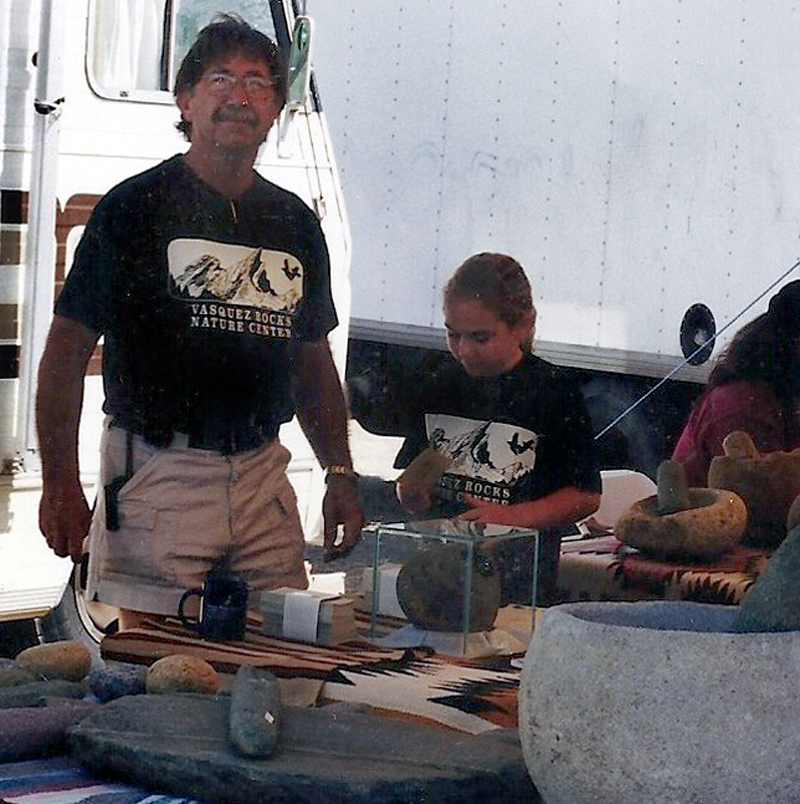
Art Brewer (left) instilled in his daughter Sarah (right) an appreciation for archaeology at an early age. Here, they're seen at a Vasquez Rocks Nature Center Associates event with some of the artifacts found in the area. Note the enormous bowl at right.
Click images to enlarge.
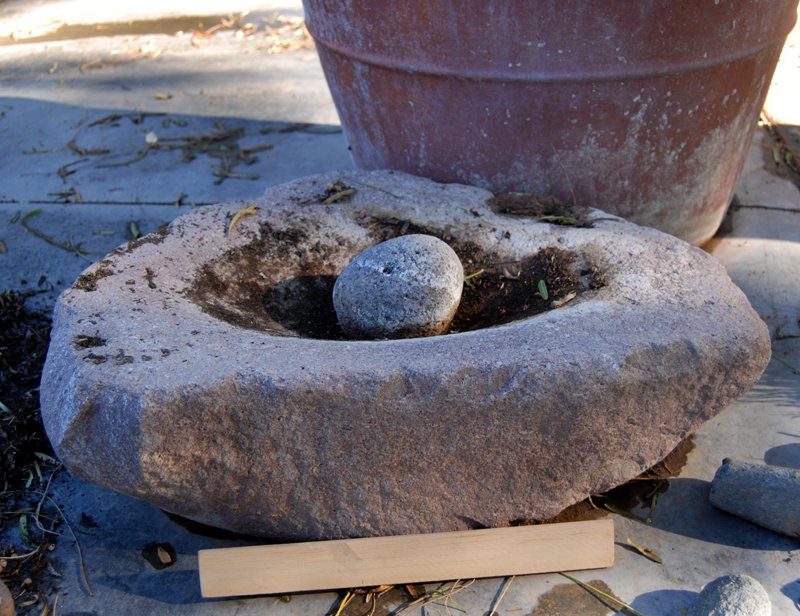
From Art Brewer's collection, this granite metate weighs 98 pounds and is believed to have been found during grading for a house in the 1950s or '60s.
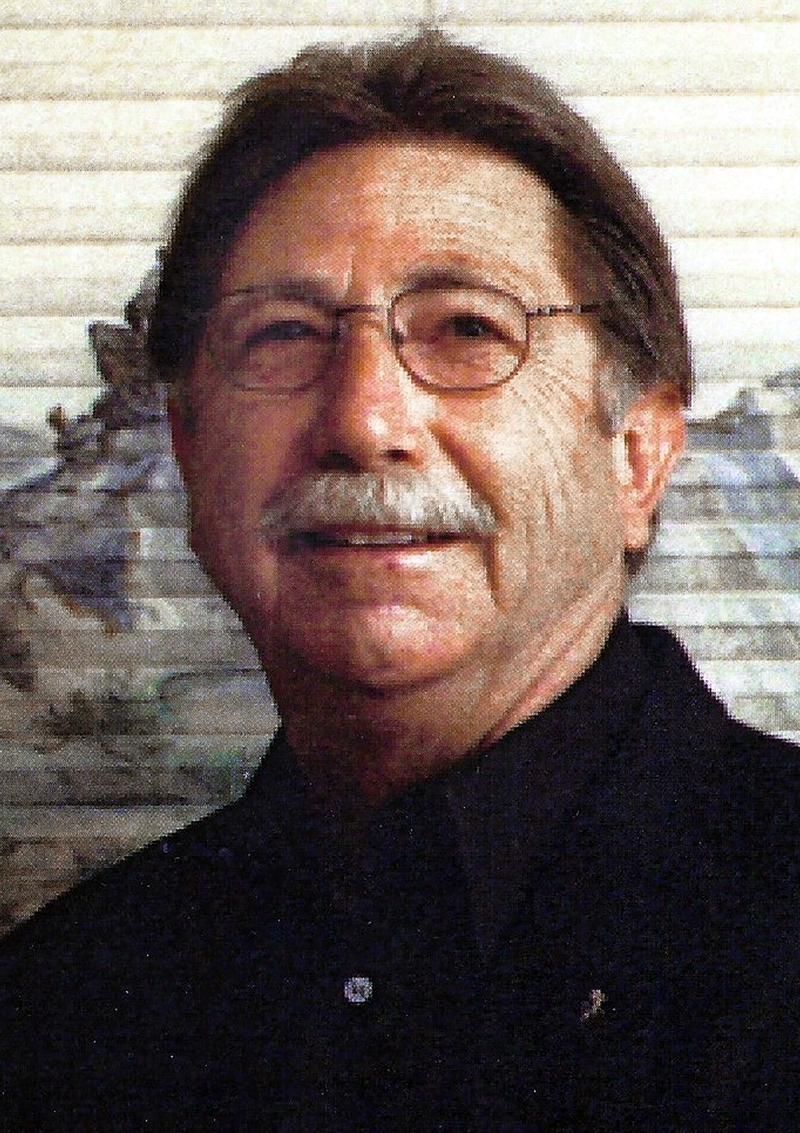
At home in Agua Dulce, had his window blinds painted with an image of Vasquez Rocks.
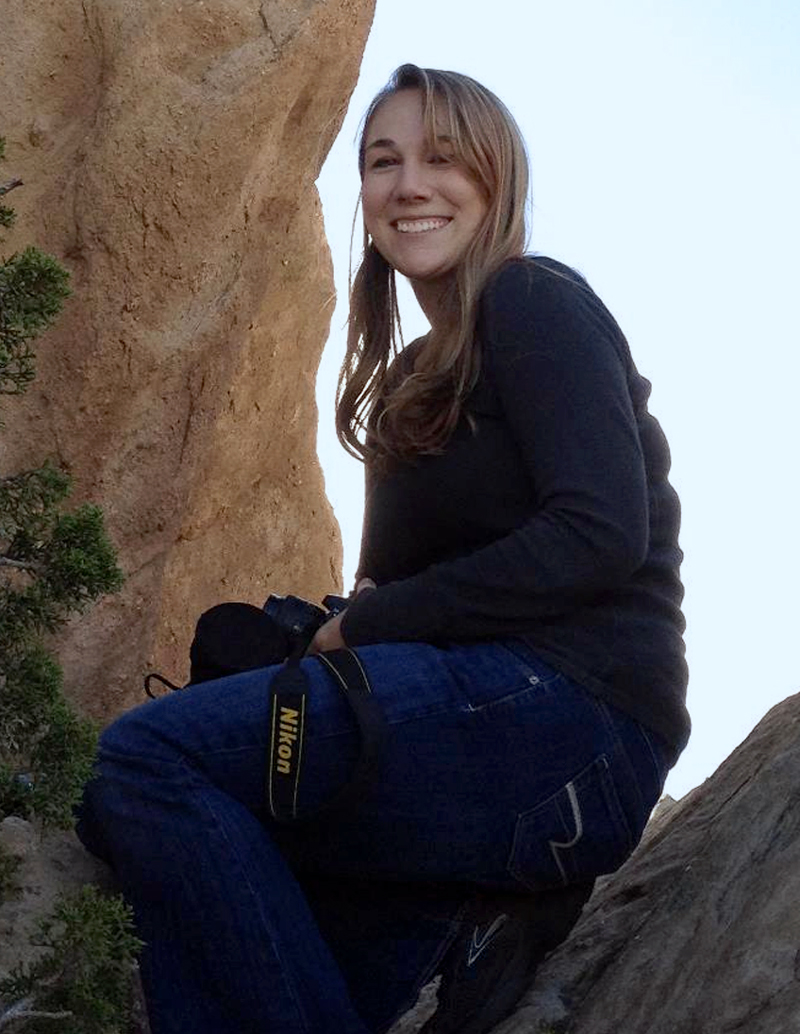
Art's passion rubbed off on daughter Sarah, who became an archaeologist. She's seen here at Vasquez Rocks.

A large, 32-inch-long grinding slab is used to display several granite pestles, or rollers, that show a diversity of color. Most came to Art Brewer by way of Kay Clawson, whose name will be associated with them at the Intepretive Center.
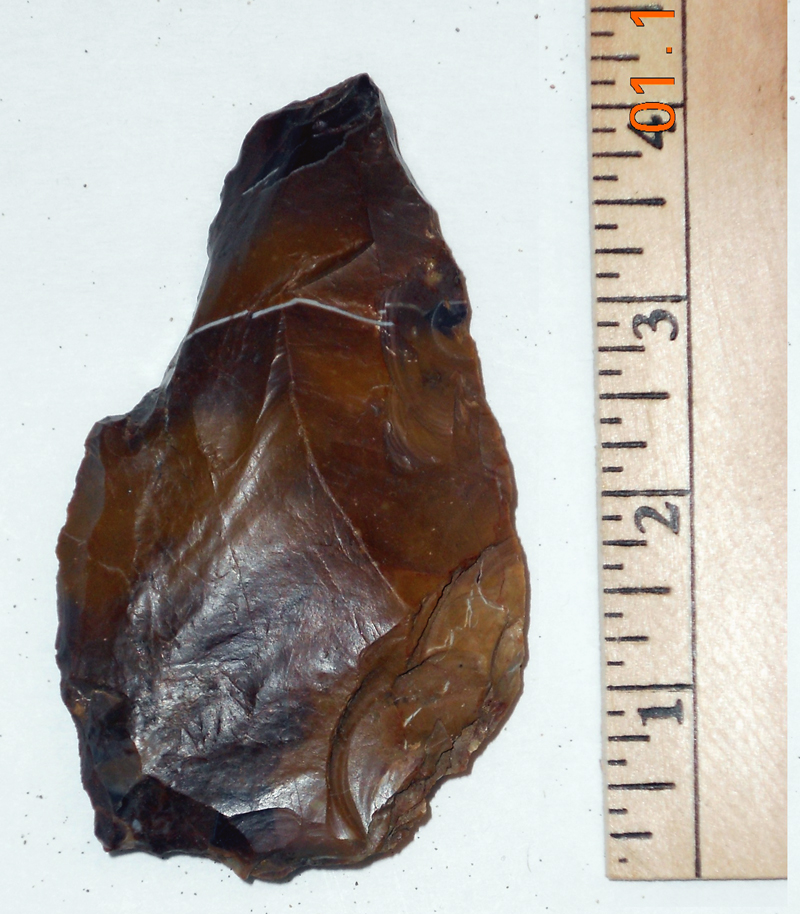
A stunning example of a bifaced jasper implement from Art Brewer's collection.
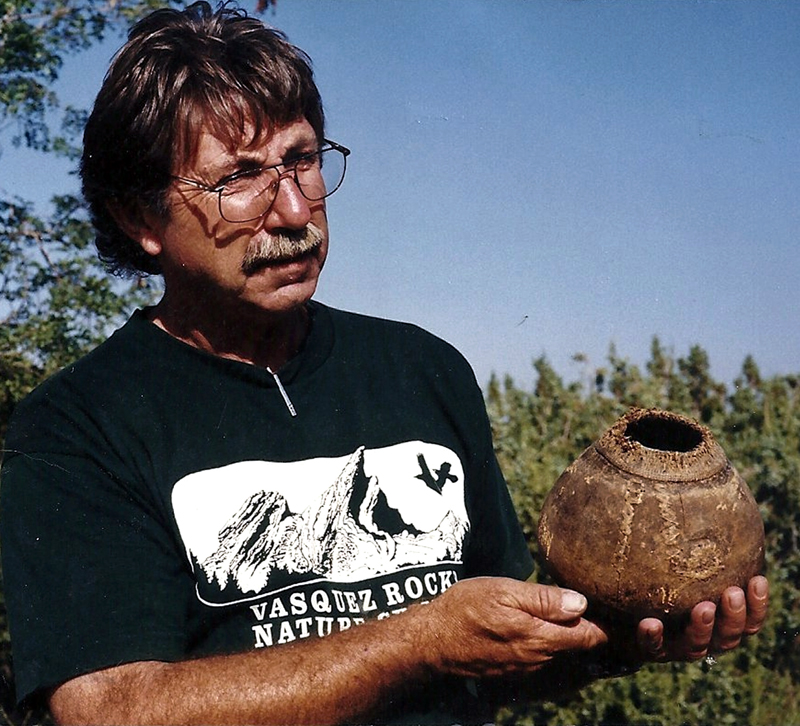
Art displays a peculiar oak-gall bowl, which you can see here. It's not part of his collection."I do not think the measure of a civilization
is how tall its buildings of concrete are,
But rather how well its people have learned to relate
to their environment and fellow man. "— Sun Bear of the Chippewa Tribe
Dreams do come true — even if they need to skip a generation sometimes.
In 2000, Agua Dulce resident Art Brewer said: "All I'm trying to do is make sure our local history is properly preserved."
His dream was for his small community to have a place where people from all over can visit and learn about the area's history and natural importance.
He didn't live to see his dream become reality.
But later this year his daughter, Sarah, will walk the halls of that dream, leading visitors on tours through time, showing them many of her father's cherished artifacts.
Construction of the new Interpretive Center at Vasquez Rocks County Park is nearing completion.
"I wish so badly that he could see all of this," Sarah Brewer said. "But I have to keep in mind that none of it would be if it weren't for him."
Art Brewer was a gentle soul with great passion. By profession he made movie magic — special effects for film and TV — since he was a teenager. For more than 40 years he was also a member of Local 44, a large union for craftsmen in the industry; for the last year and a half of his life, he was the chapter's business agent.
Art was the keeper of the past in his Agua Dulce community. His neighbors often looked to him for help and advice about how to preserve remnants of a distant past that was fast disappearing. People brought him things they found on their land because they knew he'd take good care of them.
His daughter, Sarah, is a chip off the old block.
"Many of the artifacts that will be going into the Interpretive Center will indeed come from those that are in my family's care," Sarah said. "I have grown up with these artifacts, and you can feel just by holding them, how special they are. It is so cool to hold these pieces, feel their polished surfaces, and think of the mouths they fed hundreds to thousands of years ago."
Groundstones such as manos and metates — different types of rocks that were used as food processing implements — as well as projectile points, decorative soapstone pendants, bone tools and many more will be on display.
"As a professional archaeologist, I am very proud to say that none of the pieces in the collection were found in burial contexts," Sarah said. "Most of them (served) as food preparation implements, hunting tools or as decoration. Working with native Americans" — mainly those of Tataviam/Fernandeño or Chumash decent — "I deeply respect keeping burial goods with those they were meant to be with."
The area was once home to a little-known tribe, the Tataviam, who arrived in the Santa Clarita Valley around AD 450. They lived a fairly pastoral life until the Spanish padres arrived and absorbed them into the missions, along with the other Southern California Indian groups.
Various artifacts are scattered all over the area, providing clues about their lifeways. Many have been discovered by educators, archaeologists or during a construction.
Brewer Collection
Art's extensive collection of artifacts came from private properties in and around Agua Dulce. He never dug for any of it himself, but his great passion for local archaeology ensured that people brought their finds to him for safekeeping.
"The collection that is in my family's care is one that was put together with a lot of love," Sarah Brewer said. "All of the artifacts came from private properties in Agua Dulce, most of whom were homeowners who built their homes before there was archaeology practiced in great depth in relation to construction (as there is today).".
One of the private landowners was Kay Finley Clawson, whose artifacts inevitably made their way to the man who she knew would take the best care of them.
"I like to think of her as Agua Dulce's first lady of history," Sarah said. "She made and circulated hand-drawn pamphlets that talked about the native prehistory of Agua Dulce, as well as the homestead and mining histories of our town.
"Kay felt the best thing to do for the artifacts would be to leave them with my dad, so she entrusted some beautiful pieces to our care. I am glad to say that when the Interpretive Center opens, they will be there with her name on them."
Like her father, Sarah has — some might say unorthodox — ideas about these artifacts.
"Just as my dad always felt, I deeply feel that this collection does not belong to my family. (The artifacts) belong to everyone who wants to enjoy them. They belong to the descendants of those who live here, the people who live here now, and those who are to come in the future."
These everyday-use artifacts — food preparation implements, decorations, art and even food sources — make wonderful educational pieces "as they give voices to those who lived before who are not here to speak with us today," Sarah said.
"Although my dad was not professionally or academically trained in archaeology, he had an incredible way about him to be able to listen to what these pieces had to say."
Family Tradition
Art Brewer's natural curiosity and respect for these artifacts and the stories they told were not lost on his daughter. Sarah received a double bachelor's degree from California State University, Northridge in anthropology and history, a study choice greatly influenced by her father's love for the past.
"I never wanted to do anything else with my life," she said. "From preschool on, I loved archaeology because of my dad. I recently found one of the assignments from school when I was about 7. I wrote, ‘I want to be an arkialagist (hard word to spell) bekus it's fun!' And it is."
Sarah is currently working for several companies doing cultural resource management, archaeology that is applied to construction settings. She has also worked as a monitor during the Interpretive Center's construction process, and helped select the artifacts that will be on display there.
Art died May 24, 2003, at age 57 in his Agua Dulce home after a year of fighting small-cell lung cancer.
"It was pretty aggressive and was a terminal diagnosis," Sarah remembers. "He still fought his hardest to beat it. So sad."
Now, his legacy lives on in his daughter.
"My dad cared about this Interpretive Center and these artifacts almost more than anything. I think his greatest gift he gave to me was his passion about history and respecting those who have come before us. By learning about our collective history, I have noticed that people become so much more tolerant and respectful of one another.
"Our human past is one thing that we all have in common, and when you can see and feel remnants of these histories, it is a feeling like nothing else in the world."
©2012 Katalin Szabolcsi & SCVHistory.com | Unattributed photos courtesy of Sarah Brewer | Online images only | Original scans on file
The site owner makes no assertions as to ownership of any original copyrights to digitized images. However, these images are intended for Personal or Research use only. Any other kind of use, including but not limited to commercial or scholarly publication in any medium or format, public exhibition, or use online or in a web site, may be subject to additional restrictions including but not limited to the copyrights held by parties other than the site owner. USERS ARE SOLELY RESPONSIBLE for determining the existence of such rights and for obtaining any permissions and/or paying associated fees necessary for the proposed use.